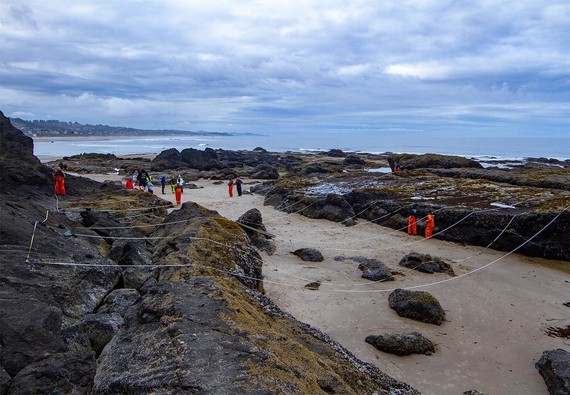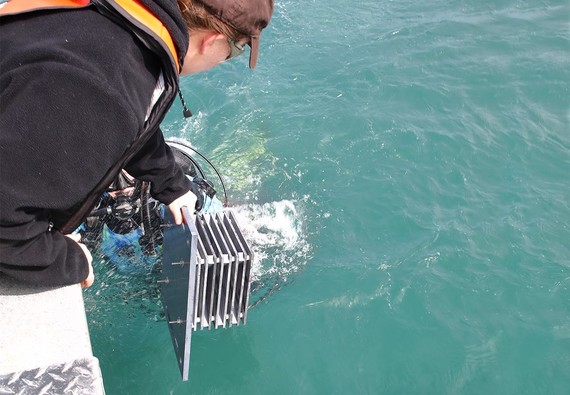ROVing THE SEAFLOOR
Click the video to watch how the ROV is launched, and see some of the underwater research footage that it collects.
Up until two decades ago very few people had seen the seabed under Oregon’s nearshore waters deeper than what an average SCUBA diver could explore. This productive strip of the ocean bumps up along the shoreline, and extends about three miles out to sea. Ironically, for a state famous for exploration, the deeper portions of Oregon’s nearshore were largely unexplored until the 1990’s. All that began to change with the use of remotely operated vehicles, or ROVs.
Underwater video collected by ODFW's ROV played a prominent role in the initial discovery and documentation of hypoxia (low oxygen) off the central Oregon coast in 2002. More recently, long term video data collected by the ROV has been used to show the impacts of sea star wasting disease below the surface. The ROV is also one of the core tools used by ODFW to monitor Oregon’s marine reserves.
Read more about ODFW's long history of ROV research in Oregon
 Click the video to watch a time lapse of the mooring deployment.
If you're out at Roads End, north of Lincoln City, you might notice a bright orange flag bobbing above the surface of the water. It’s the most recent installation of oceanographic sensors by the ODFW Marine Reserves Program.
The oceanographic sensors were deployed on June 25th to track oceanographic conditions including temperature, salinity, and oxygen levels every hour of the day for the next few months. Information from these instruments is helping us understand nearshore oceanographic conditions at Cascade Head, such as if and when hypoxic (low oxygen) conditions occur and how long they last.
 The ODFW Marine Reserves Program took advantage of several big, low tide series in June and early July to head out into the rocky intertidal to perform biodiversity surveys (pictured above), sea star surveys and mussel bed surveys. The intertidal biodiversity surveys are led by our collaborators at UC Santa Cruz as part of the Multi-Agency Rocky Intertidal Network (MARINe) which has been collecting long term data at over 100 intertidal sampling sites between Alaska and Mexico. You can find more about Oregon’s rocky intertidal areas and our monitoring surveys on our website.
Explore more of the rocky intertidal areas found in Oregon’s marine reserves on our Flickr page.
 Dr. Lindsay Aylesworth, Ecological Reserach Project Leader, holds up a quillback rockfish that was caught, measured (and released) during spring hook and line surveys.
 |
|
We completed our spring hook and line survey at Cape Falcon, and hook-and-line/longline survey at Redfish Rocks. Our fall surveys will start at both sites in August. |
 |
|
Thanks to the help of our volunteer scientific divers, we completed all SCUBA surveys slated for June. Surveys will start back up this fall when underwater visibility tends to improve. |
 |
|
We installed two oceanographic devices in June, one at Cascade Head and one at Cape Falcon. Take a peek at this video taken while at sea at Cascade Head. |
 |
|
Our staff led a rocky intertidal undergraduate workshop with Dr. Selina Heppell’s students, from Oregon State University, at Otter Rock in mid-June. We also participated in two Bioblitz events organized by the Oregon Coast Aquarium. A big thanks to OMSI for inviting us to host an Oregon Marine Reserves outreach table at last month’s OMSI After Dark: Ocean event in Portland. |
UPDATES FROM OUR COLLABORATORS
 Autonomous Reef Monitoring Structures, called ARMS for short, as a standardized way to quantify biodiversity. Arms are installed on the seafloor via SCUBA divers.
 |
|
We continued collecting samples from SMURFs set out at Otter Rock and Redfish Rocks as part of juvenile fish recruitment surveys, led by Oregon State University and in collaboration with the Oregon Coast Aquarium. We’ve been seeing pulses of juvenile cabezon, rockfishes, and kelp greenling this past month. We’ve also seen a small handful of snailfish and clingfish in our samples. These surveys will be continuing through the summer. |
 |
|
We conducted biodiversity, sea star, and mussel bed surveys in rocky intertidal areas at both Otter Rock and Cascade Head. Check out photos of our research on our Flickr page. |
 |
|
Our staff went down to the Oregon Institute of Marine Biology to meet up with researchers from the Smithsonian Institution to learn more about processing samples collected using underwater structures called ARMS to help us study biodiversity in the marine reserves. Smithsonian researchers have been using ARMS to study marine invertebrate biodiversity on reefs around the world for more than half a decade. |
Explore More Marine Reserves News
|